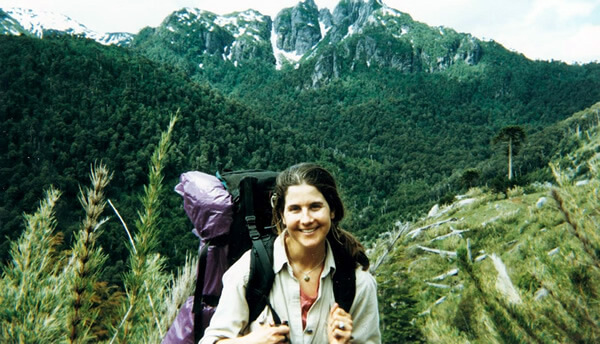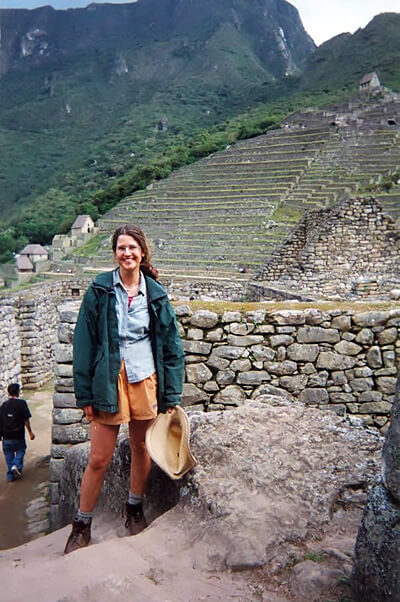Tips for Solo Woman Travel in South America
Article and photos by Amy Stix Miller

|
|
Backpacking in northern Patagonia, Chile.
|
On my last afternoon at home before departing on a much anticipated, year-long solo journey through South America, I had a meltdown over duct tape or the lack thereof. A staple in my backpack for quick repairs of ripped rain pants or threadbare boots, I had forgotten this item in one final, blurry blaze of frantic preparation.
But it wasn't the missing tape that caused my waterworks. I knew what lurked behind the tears.
I was scared — even somewhat terrified. In about twelve hours, I was heading alone to a continent where I did not know a soul. Beyond a couple banal pleasantries ("hello" and "goodbye"), I could not speak a lick of the language. Mixed with these worries were the closeness to family, friends, a beloved old dog, and an implicit concession that, as a woman of a certain age, perhaps I should be heading out on a job hunt rather than an extended trip.
Well-intentioned supporters only added to my creeping dread with admonishments for the solo female globetrotter: "Be careful! It sounds kind of dangerous. Don't go out alone at night." The butterflies-in-the-stomach feeling of expectation and exhilaration had given way to nausea.
But plane tickets being what they are, I was hurtling through the dark at 3 a.m. the following day on an LAX-bound airport shuttle and then onto a Peru-bound flight.
When the plane finally touched down in the southern hemisphere, the gentler butterflies returned, and I never looked back. Landing on an unknown continent amidst its layers of novel landscapes, people, and languages proved one of my life's most rewarding experiences. Ultimately, I scrapped my return ticket and extended the trip until the money ran out.

|
|
Enjoying Machu Pichu after a 4-day trek.
|
And that duct tape did come in handy. On a road trip across Bolivia's remote salt flats with my guide and a few fellow travelers, it provided the temporary fix to a broken hose, getting us safely on our way — and then onto the next adventure.
By following some common sense tips, a few of which were offered by the South American women and men I encountered on the road, exploring this captivating continent is indeed a safe and wondrous experience for the solo female traveler.
-
Learn some language basics. Knowing a few greetings and phrases in Spanish (and Portuguese in Brazil) is invaluable for meeting people, getting around, and asking for directions and assistance.
-
While most offers — and you will get many — to carry your luggage to a bus terminal or hostel lobby are well-intentioned, some are not. Politely insist on carrying your backpack and/or daypack wherever you go.
-
Load your own belongings onto a bus (either in the hull or secured on top), train, taxi, or watch to ensure your things are correctly loaded and unloaded. Larger bus companies that travel to popular destinations and cities often provide a claim check for any item you store.
-
Watch your belongings at crosswalks, which is a popular site for pickpockets. Be mindful of those standing in front and behind you. The same rule applies to public transportation.
-
Daypacks and purses sometimes get stolen from Internet cafes, restaurants and other tourist hangouts. Don't place packs or bags on the back of a chair or even loose under the table. Avoid losing a pack by keeping a foot through an arm strap. Keeping a foot or hand on your pack will help ensure it remains with you.
-
The best way to thwart unwanted advances from men is to avoid eye contact or saying hello as you pass on the street. Walk purposefully. This can feel rude at first, but it's effective. If someone persists in making an unwanted advance, be firm. Be loud. It works.
-
Use “radio taxis” to get around cities after dark. Radio taxis belong to private companies, are well-marked, and are quickly dispatched at any time of the night. Many individuals in South American cities operate their own taxi services using personal vehicles. I used these (often cheaper) services during the day but was advised to use radio taxis at night. Most anyone can charge for a car ride, but you don't know whose car you are entering; robberies have occurred in some individual taxis, especially at night.
-
When possible, connect with groups of fellow travelers for explorations. Most of the time, I found them willing to let me tag along, and I made some great friends there.
-
Join a group to visit bars, clubs, and sports matches. Though going to a sporting event or club can be a great way to experience the local social scene, it's not the norm for South American women to partake in these activities alone. Plus, a Pisco Sour or glass of Chilean red is much more enjoyable when shared with friends.
-
If it’s not possible to connect with a group, discreetly lag behind travelers heading to the same destination you want to visit. While discussing a solo hike to a secluded Brazilian beach, locals warned me that the forested trail I planned to take was unsafe for a woman alone. I waited near the trailhead until a couple began the same hike. Sensing they were on a romantic getaway, I followed just within sight. This respectable distance allowed them to feel safe while providing me some security.
-
When exploring a new city, tourist spot, or hiking area, let someone you trust know where you're going and when they can expect you back. You might tell your plans to a fellow traveler or a trustworthy café, hostel proprietor, or tourist office official.
-
If you are heading out on an excursion alone with a male guide, get some references first. Though most guides you meet in South America are courteous professionals, there are occasional reports of inappropriate behavior and unwanted advances from male guides toward their female clients. (This issue is definitely common in South America!) Spending a little more money on a reputable tour agency or guide service is worthwhile. Whenever I headed out on an excursion alone with male guides, I got at least two recommendations from females I trusted. Trusted sources of information include proprietors of reputable youth hostels and restaurants, travel agencies, fellow travelers, and tourist offices.
-
Once you have your recommendations, go for it! One of the best hikes I've ever taken was a trek into a cloud forest in northern Bolivia, where only a few tourists venture. I spent eight hours alone with two male guides. I shared terrific conversations and laughs while exploring waterfalls, tropical wildlife, and incredible vistas.
-
Leave the thong at home — or at least hide it! I watched indigenous women on a bus in rural Bolivia aghast at the sight of a female backpacker's fire engine red thong spilling out of her low-slung jeans. Though that trend might fly in Rio de Janeiro, in rural South America, this type of dress is considered offensive. Dressing respectfully and following the general mores of where you are traveling go a long way to ensuring a hassle-free trip.
-
Go with your instincts. If a guide, trail, or other location doesn’t feel right, don’t pursue it.
During my travels, I was surprised at how seldom I was alone. So many people I met, whether they were from Bolivia, Argentina, Brazil, or another South American country, were immediately concerned when I told them I was traveling solo. "It's too dangerous out here for a woman on her own!" was a common refrain. I felt completely the opposite. I often received unsolicited help, ranging from directions to offers of meals, homestays, and even the occasional matchmaking attempt. During my experience, I found South Americans among the world's friendliest, warmest, and most inviting hosts.
Amy Stix Miller spent 14 months studying, volunteering, and traveling independently in South America. Based in Montana, she has worked as a researcher/writer in environmental conservation. She founded a non-profit organization to support literacy projects and libraries in Bolivia, where she returns as often as possible.
|
